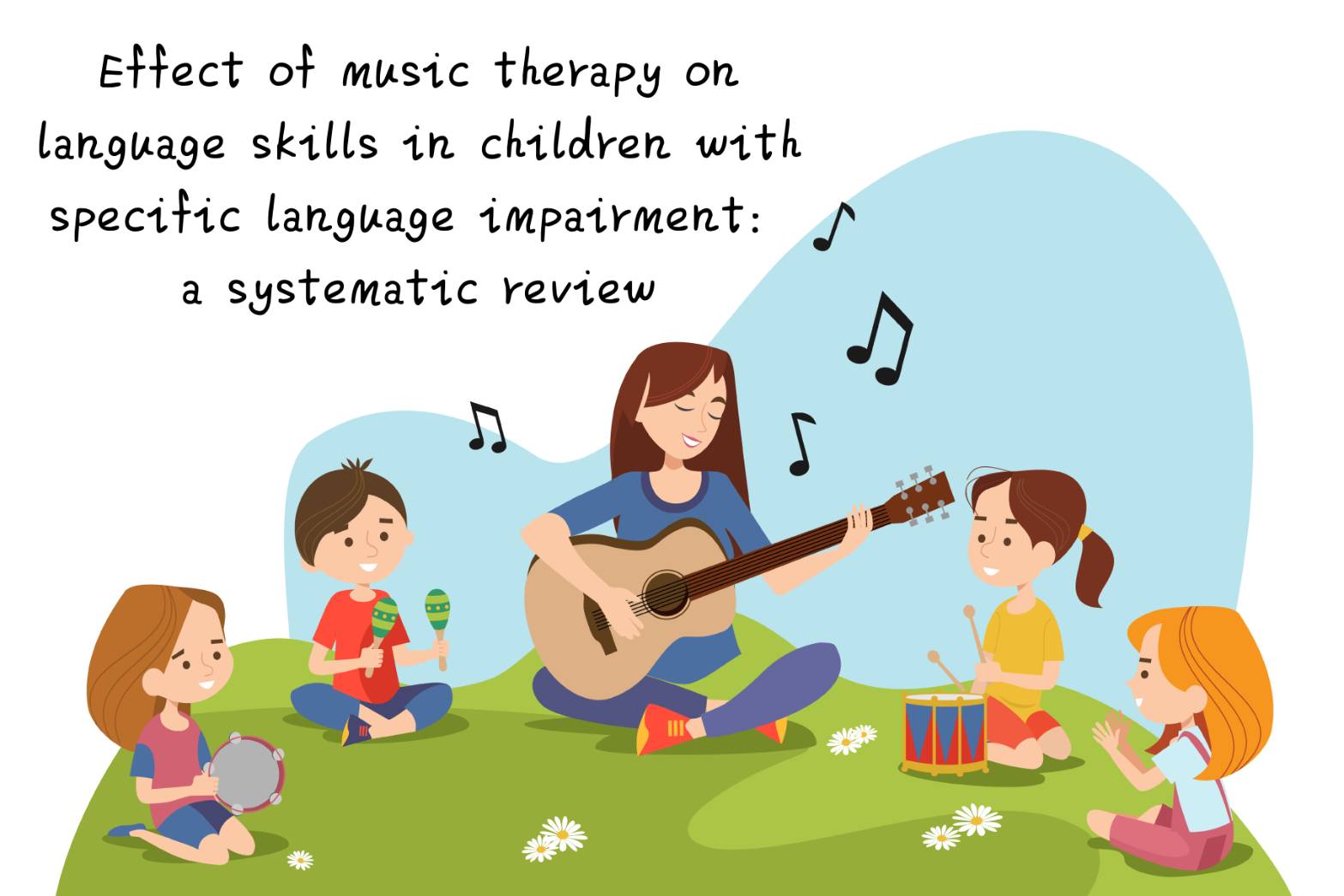Effect of music therapy on language skills in children with specific language impairment: A systematic review
Main Article Content
Abstract
Background: Specific language impairment (SLI) delays language development without any neurological damage or disease. This impairment extends to nonlinguistic tasks, such as music perception skills. In recent years, speech-language pathologists (SLPs) and music therapists (MTs) have collaborated to develop and improve approaches for children with communication disorders (CDs), including global developmental delay (GDD), SLI, mild developmental delay (DD), and the risk of developing reading difficulties, by integrating music therapy (MT) and speech therapy (ST). MT could be considered as one of the alternative methods offered to children with SLI to enhance their language skills.
Objectives: The purpose of this study was to investigate the effectiveness of MT interventions on language skills in children with SLI and to investigate the characteristics of other intervention features in these studies, such as interventionists, intervention, settings, session type, and music methods.
Materials and methods: The study was a systematic review conducted within the framework of the Preferred Reporting Items for Systematic Reviews and MetaAnalyses (PRISMA). The quality of the research results was assessed using the critical appraisal tools provided by the Joanna Briggs Institute (JBI).
Results: Two studies met the inclusion criteria and were included in this systematic review. The two main types of MT employed were song cues and creative music therapy based on the Nordoff-Robbins approach. Current evidence suggests that music therapy improves components of language, including phonology, syntax, morphology, and other aspects of speech development, such as understanding sentences and memory for sentences, in children with SLI.
Conclusion: MT can be a valuable and effective intervention for children with SLI. The introduction of transdisciplinary programs that integrate MT and ST could be recommended. However, MT training courses are required for SLPs.
Article Details

This work is licensed under a Creative Commons Attribution-NonCommercial-NoDerivatives 4.0 International License.
Personal views expressed by the contributors in their articles are not necessarily those of the Journal of Associated Medical Sciences, Faculty of Associated Medical Sciences, Chiang Mai University.
References
Leonard LB. Specific language impairment across languages. Child Dev Perspect. 2014; 8(1): 1-5. doi:10.1111/cdep.12053.
Bishop DV. Why is it so hard to reach agreement on terminology? The case of developmental language disorder (DLD). Int J Lang Comm Dis. 2017; 52(6): 671-80. doi:10.1111/1460-6984.1233.
Bishop DV, Leonard LB, editors. Speech and language impairments in children: Causes, characteristics, intervention and outcome. Psychology Press; 2000.
Fey ME, Long SH, Finestack LH. Ten principles of grammar facilitation for children with specific language impairments. Am J Speech Lang Pathol. 2003; 12(1): 3-15. doi:10.1044/1058-0360(2003/048).
Gillam SL, Kamhi AG. Specific language impairment. The handbook of language and speech disorders. 2010: 210-26. doi:10.1002/9781444318975.
Goffman L, Leonard J. Growth of language skills in preschool children with specific language impairment: Implications for assessment and intervention Am J Speech Lang Pathol. 2000; 9(2): 151-61. doi:10.1044 /1058-0360.0902.151.
Mari G, Scorpecci A, Reali L, D’Alatri L. Music identification skills of children with specific language impairment. Int J Lang Commun Disord. 2016; 51(2): 203-11. doi:10.1111/1460-6984.12200
Lerdahl F. Tonal pitch space. Oxford University Press, USA; 2001.
Deutsch D. The processing of pitch combinations. InThe psychology of music 1999 Jan 1 (pp. 349-411). Academic Press. doi:10.1016/B978-0122135644/500 11-1.
Levitin DJ. This is your brain on music: The science of a human obsession. Penguin; 2006 Aug 3.
Schmidt-Jones C. The basic elements of music. Connexions; 2012.
Kraus N, Skoe E, Parbery-Clark A, Ashley R. Experienceinduced malleability in neural encoding of pitch, timbre, and timing: Implications for language and music. Ann NY Acad Sci. 2009; 1169(1): 543-57. doi:10.1111/j.1749-6632.2009.04549.x.
Patel AD. A neurobiological strategy for exploring links between emotion recognition in music and speech. Behav Brain Sci. 2008; 31(5): 589-90. doi:10.1017/ S0140525X0800544X.
Koelsch S. Neural substrates of processing syntax and semantics in music. Springer Vienna; 2009.
Patel AD. Language, music, syntax and the brain. Nat Neurosci. 2003; 6(7): 674-81. doi:10.1038/nn1082.
Leonard MK, Cai R, Babiak MC, Ren A, Chang EF. The peri-Sylvian cortical network underlying single word repetition revealed by electrocortical stimulation and direct neural recordings. Brain Lang. 2019; 93: 58-72. doi:10.1016/j.bandl.2016.06.001.
American Music Therapy Association. Available at http://www.musictherapy.org. Accessed Aug 2, 2023.
Adamek M, Darrow AA. Music in special education. Silver Spring, MD: American Music Therapy Association; 2005.
Geist K, McCarthy J, Rodgers-Smith A, Porter J. Integrating Music Therapy Services and SpeechLanguage Therapy Services for Children with Severe Communication Impairments: A Co-Treatment Model. J Instr Psychol. 2008; 35(4): 311-6.
Kouri TA, Winn J. Lexical learning in sung and spoken story script contexts. Child Lang Teach Ther. 2006 Oct;22(3):293-313 doi:10.1191/026565900 6ct309xx.
Kouri T, Telander K. Children’s reading comprehension and narrative recall in sung and spoken story contexts. Child Lang Teach Ther. 2008; 24(3): 329-49. doi:10. 1177/0265659008096296.
Page MJ, McKenzie JE, Bossuyt PM, Boutron I, Hoffmann TC, Mulrow CD, Shamseer L, Tetzlaff JM, Akl EA, Brennan SE, Chou R. The PRISMA 2020 statement: an updated guideline for reporting systematic reviews. Int Surg J. 2021; 88: 105906.
Tan EY, Shoemark H. Case study: The feasibility of using song to cue expressive language in children with specific language impairment. Music Ther Perspect.. 2017; 35(1): 63-70. doi:10.1093/mtp/miv039.
Groß W, Linden U, Ostermann T. Effects of music therapy in the treatment of children with delayed speech development-results of a pilot study. BMC Complement Altern Med. 2010; 10: 1-0. doi:10.1186/1472- 6882-10-39.
Anvari SH, Trainor LJ, Woodside J, Levy BA. Relations among musical skills, phonological processing, and early reading ability in preschool children. J Exp Child Psychol. 2002; 83(2): 111-30. doi:10.1016/S0022- 0965(02)00124-8.
Lathroum LM. The role of music perception in predicting phonological awareness in five-and six-year-old children. University of Miami; 2011.
Thaut, M. Rhythm, music, and the brain: Scientific foundations and clinical applications. Taylor & Francis; 2013.
Hazelett M, Wagner B. Specific language impairment (SLI). Muncie, IN: Ball State University; 2002.
Nordoff P, Robbins C. Therapy in Music for Handicapped Children. Barcelona Publishers; 2004.


